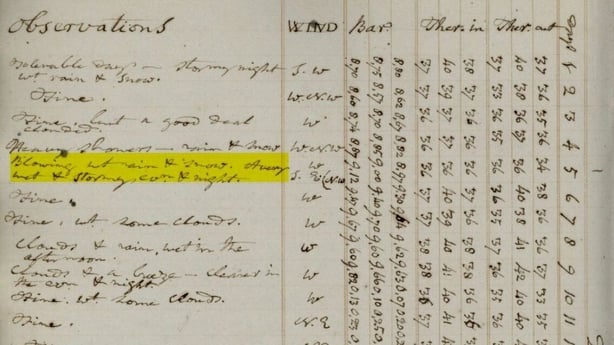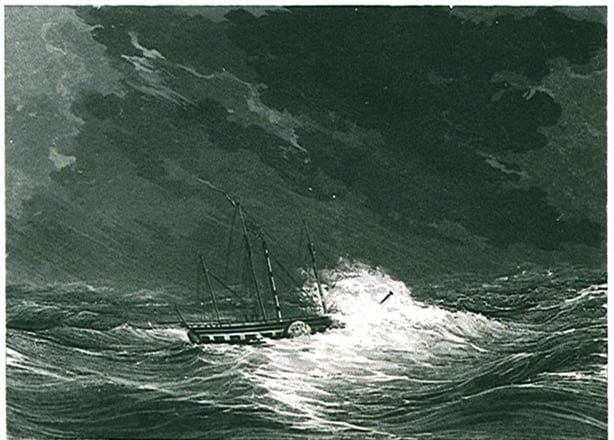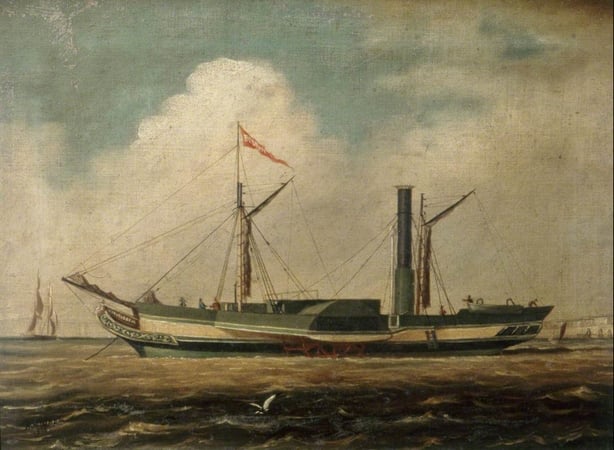Analysis: The storm is unusual in that it has not been recorded as one of the destructive weather events in Ireland in the 19th century
On December 5th 1822, a hurricane swept over Ireland and Britain wreaking havoc in its wake. It knocked over hundreds of trees, laid waste and damage to large sections of Dublin's houses and buildings and killed and maimed countless people and livestock.
The storm is unusual in that it has not been recorded in the various published collections regarding destructive weather events in Ireland in the 19th century. For example, it is not listed in F. E. Dixon's Weather in Old Dublin, nor is it present in the few publications issued by the Irish meteorological service. The violent and tragic circumstances of the event can however, be found in contemporary Irish and British newspapers, while a surviving record from the Armagh observatory hints at the storm.

Quaker John Rutty recorded over 100 storms in his diary between 1716 and 1765, although few of these were classed as severe. However, several violent weather events impacted Ireland throughout the subsequent 19th century.
For example, heavy rain in 1802 had already swollen many rivers across the island that year. When it intensified in December of that year, it led to the worst flooding ever witnessed in the city and county of Dublin. Several bridges were damaged or swept away, including Ormond Bridge on the Liffey close to the newly erected Four Courts. Dubliners witnessed dead sheep, horses and other animals being swept down the Liffey out to sea.
The most famous of these 19th century storms is the Night of the Big Wind (Oíche na Gaoithe Móire) in 1839. The damage and death toll caused by this storm was unprecedented in Irish history. It was classified as the worst weather event to impact the island within 500 years, while Storm Ulysses in 1903 was recorded as being comparatively close to the severity of 1839.
We need your consent to load this rte-player contentWe use rte-player to manage extra content that can set cookies on your device and collect data about your activity. Please review their details and accept them to load the content.Manage Preferences
From RTÉ Radio 1's History Show, remembering the Night of the Big Wind in 1839
While these storms have been well documented (the 1839 one entering into Irish folklore and weather history), the storm and hurricane of December 1822 has eluded the history books. The weather had been rough and tempestuous for a period of weeks leading up to the night of the hurricane. The previous week, a violent thunderstorm had struck Britain and Ireland with severe winds. Loud peals of thunder were reported with flashes of lightning in Glasgow.
The storm arrived from the SW and SSW and began to intensify around 5pm. The fact that the severe wind occurred in the early darkness of winter made it even more terrifying. Multiple regional Irish and British newspapers reported widespread damage nationwide. Between 5 and 9pm, the storm battered Dublin city, killing several people and maiming and injuring dozens more. It was reported that the wind was so fierce as to have forced people to travel on all fours and that every window and glass lamp within the city was shattered.
At Milltown, a row of very old elm trees were blown down, while a man was blown off his horse in Wicklow. At Kingstown Harbour (now Dun Laoghaire), several navy cruisers were driven from their moorings out to sea with many crew blown overboard. In terms of damage to houses, the biggest culprit was collapsed chimney stacks falling inward and collapsing every floor to ground or basement level. Reports of collapsing floors in Dublin, Liverpool and Manchester were rife with cruel, random stories of siblings being killed while others survived unscathed. The luck of exactly where you were within a house decided your fate. In other reports whole families were killed while others miraculously survived un-scathed.

In Henrietta Street in the north inner city, a large residential house collapsed when the chimney stacks came down pulling all four floors down with them. Miraculously the entire family who were present survived. Collapsing chimneys caused the destruction of houses on Aungier Street, Pill Lane, Love Lane, Aston Quay, Inn’s Quay, Great Ship Street, Denmark Street and in Summerhill. On Mecklenburg Street, four houses were destroyed.
The list posted in the contemporary newspaper reports was exhaustive. In the Rotunda Gardens, 20 trees were blown down, while 80 trees were lost in the Phoenix Park, in addition to the Phoenix obelisk blown over outside the Rangers residence (now Áras an Uachtaráin). An entire row of the recently completed houses on Westmoreland Street were damaged and lost their roofs. At 33 Upper Sackville Street, two deaths occurred when the roof and chimneys of Elliot’s auctioneers collapsed taking all the floors down to the ground level. A 95 year old woman and a four-year-old child inside were both killed. The damage in the suburb of Crumlin was severe with many houses collapsed while many more had their roofs blown off.
The devastating effects of the storm can be seen in the records of shipwrecks and vessels driven ashore during the period. Between December 1st and 4th, some 10 ships were lost or damaged around the waters of the UK. However, between the 5th and 6th when the storm was active, in excess of 70 ships were damaged or lost.

The packet steamer Belfast left Liverpool and was bound for Belfast on the night of the 5th. Passing the Calf of Man, the storm turned into a hurricane, and Captain Charles Stewart decided to return to port. However, as they approached the coast, the extreme conditions implored Stewart to declare to his passengers: "I have done all in my power, and it becomes my duty to tell you, that the night is so awfully dark, that I know not exactly where we are. I have been at sea for 30 years, but never a night equal to this." The ship sank close to the coast, however all souls on board survived. Many passengers on other vessels were not so lucky.
The storm was felt across the UK for a number of days after its ferocity in Dublin. On December 10th, London-based newspapers were reporting on the severity of the damage in Dublin, while reporting the after effects still being felt in Liverpool, Manchester, and beyond.
The event of 1822 was a timely reminder of the destructive force of mother nature upon a city which was yet to be lit by gas
The effects of the storm on these two cities had been reported as almost as severe as in Dublin. In both cities heavy rain and violent gusts cleared the streets and plunged them into darkness. Many families huddled by the fireside refusing to sleep in their beds, while many attempted to gain entry to jails and police stations for protection. In Dublin, the damage inflicted was estimated to be in excess of £100,000. How the damage was compensated is unclear, as insurance companies were somewhat in their infancy at the time.
The 1822 storm and subsequent damage were a precursor of what was to come in 1839 with the Night of the Big Wind and the freak hailstorm of 1850 caused massive damage all over the city. The event of 1822 was a timely reminder of the destructive force of mother nature upon a city which was yet to be lit by gas and was still absorbing its Georgian transformation.
Follow RTÉ Brainstorm on WhatsApp and Instagram for more stories and updates
The views expressed here are those of the author and do not represent or reflect the views of RTÉ







